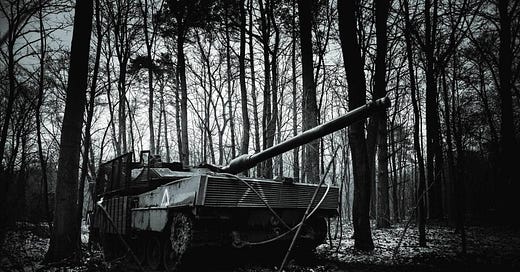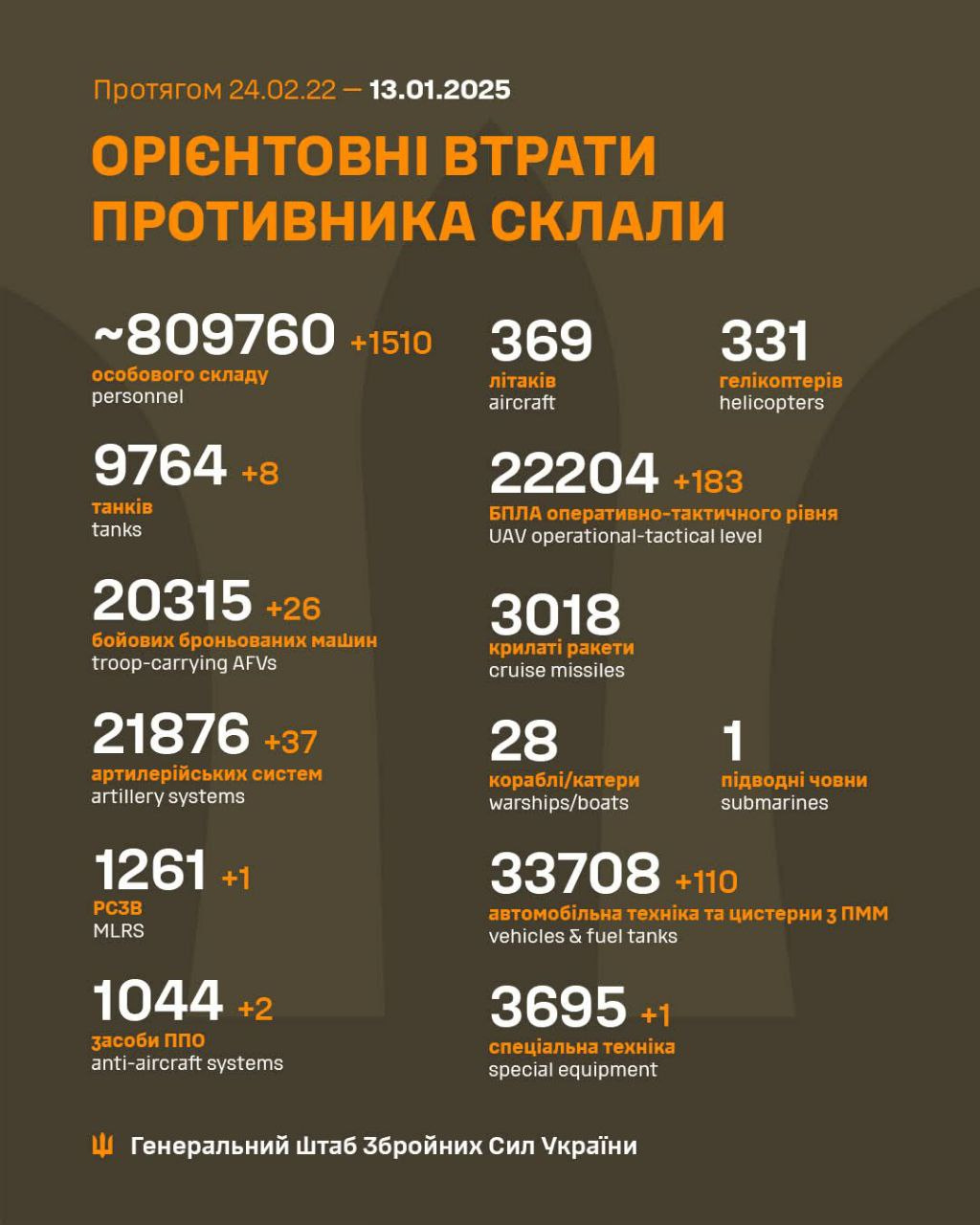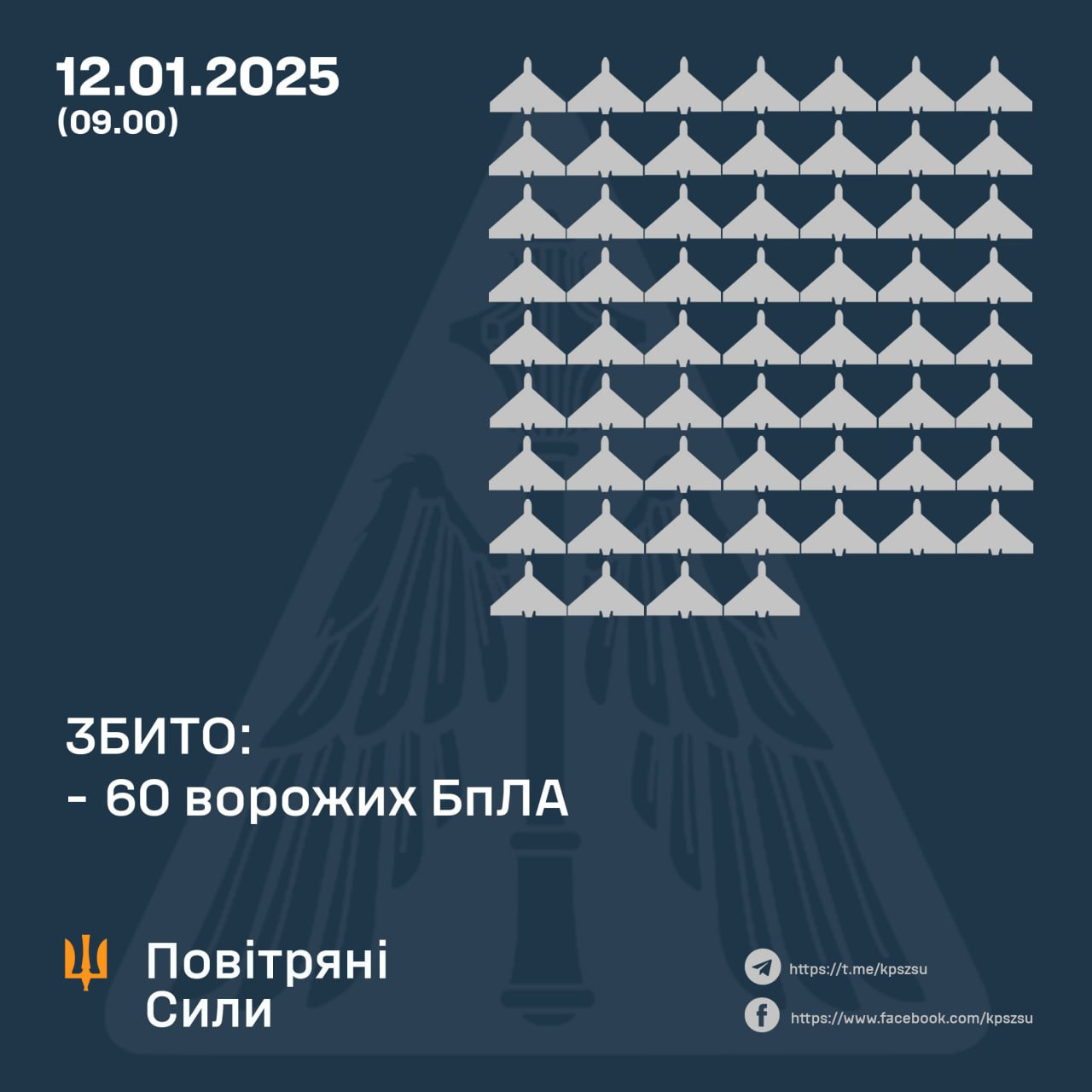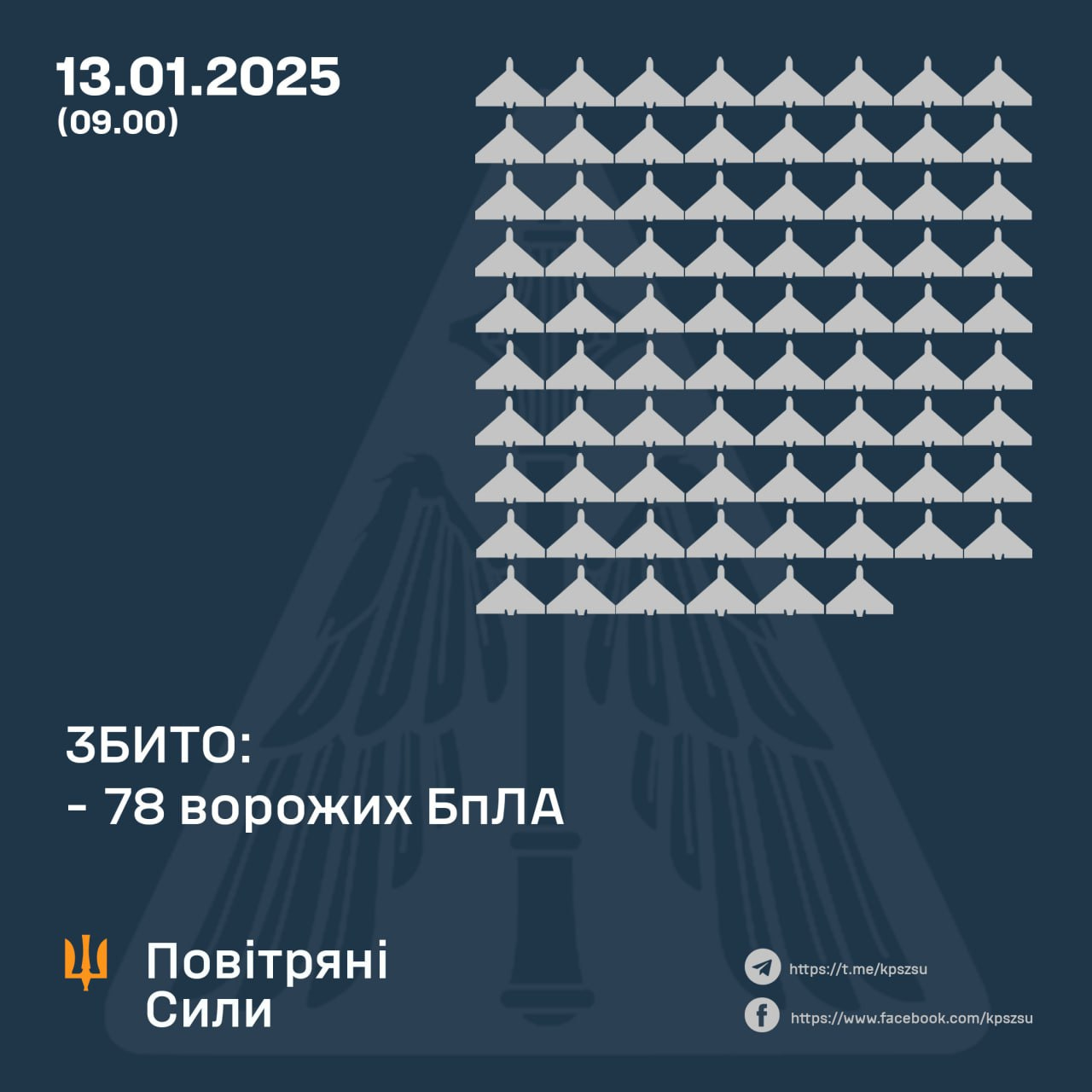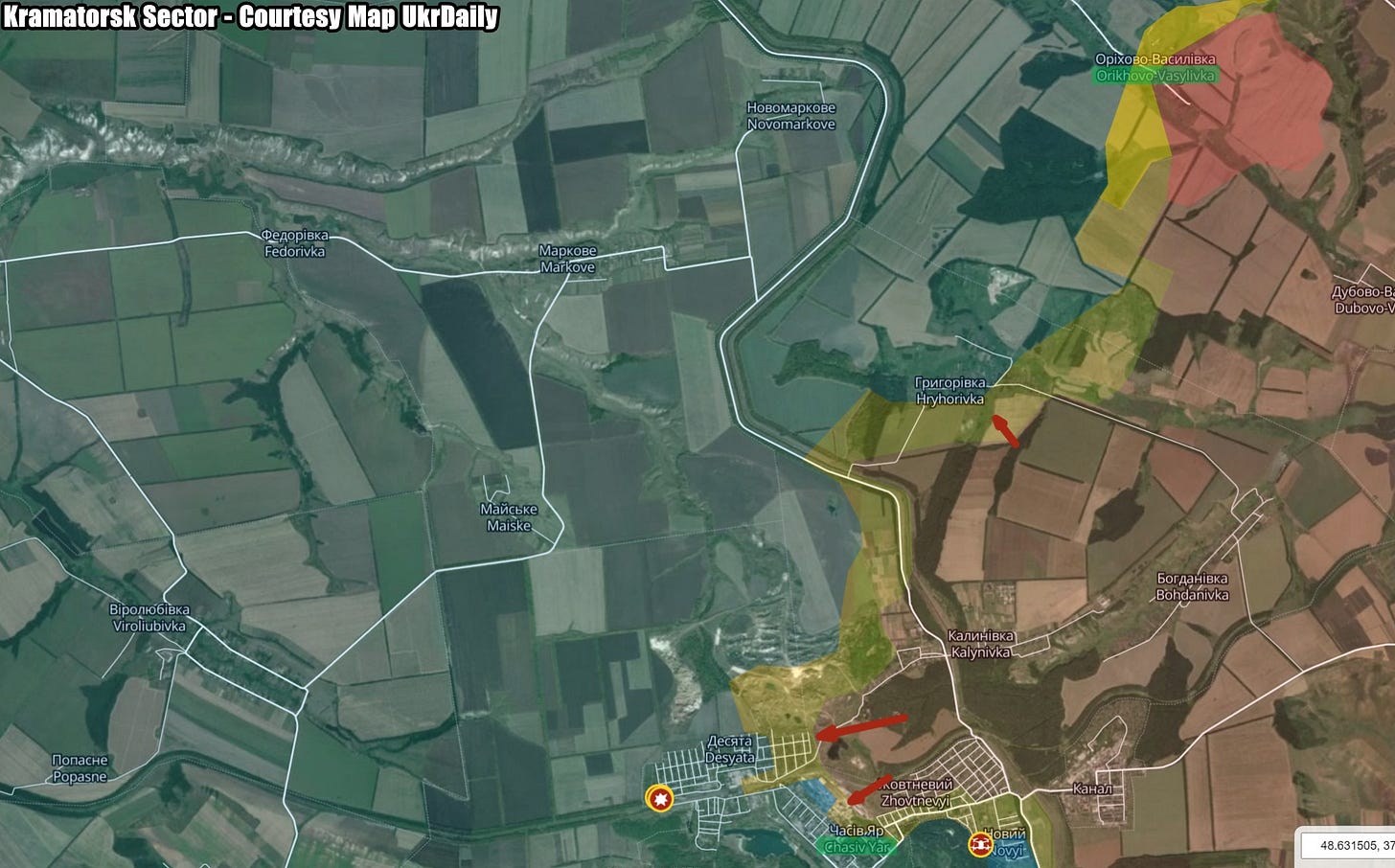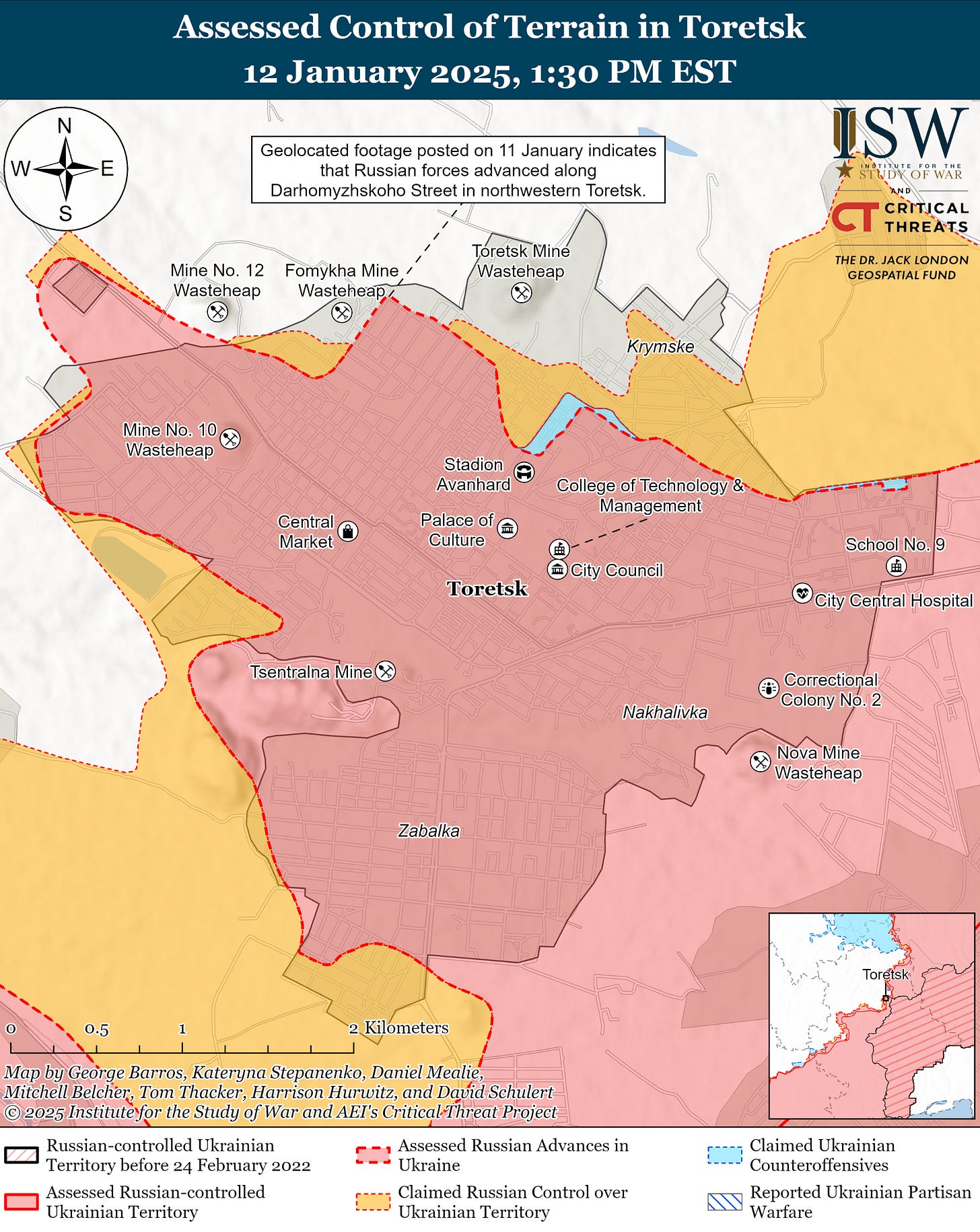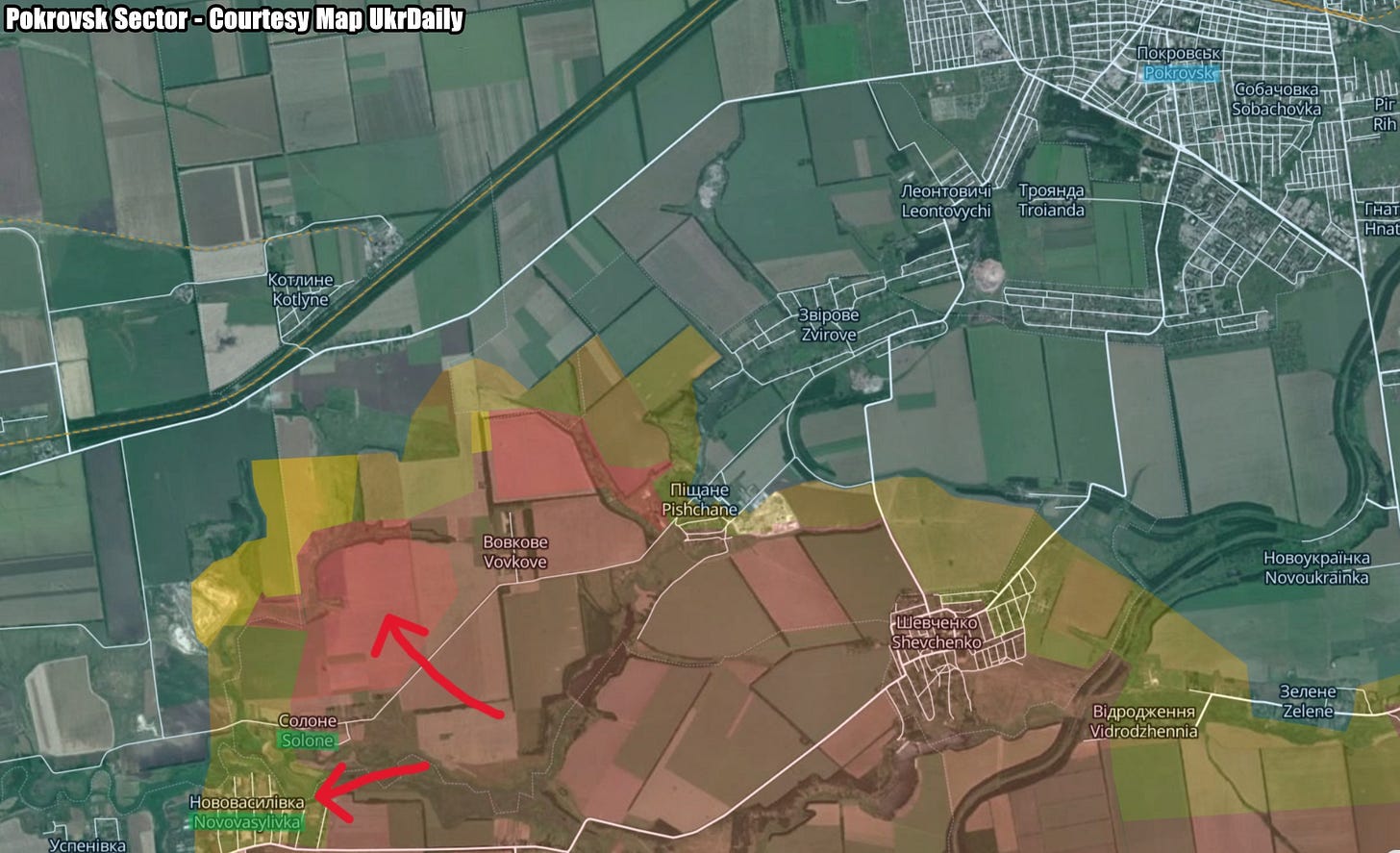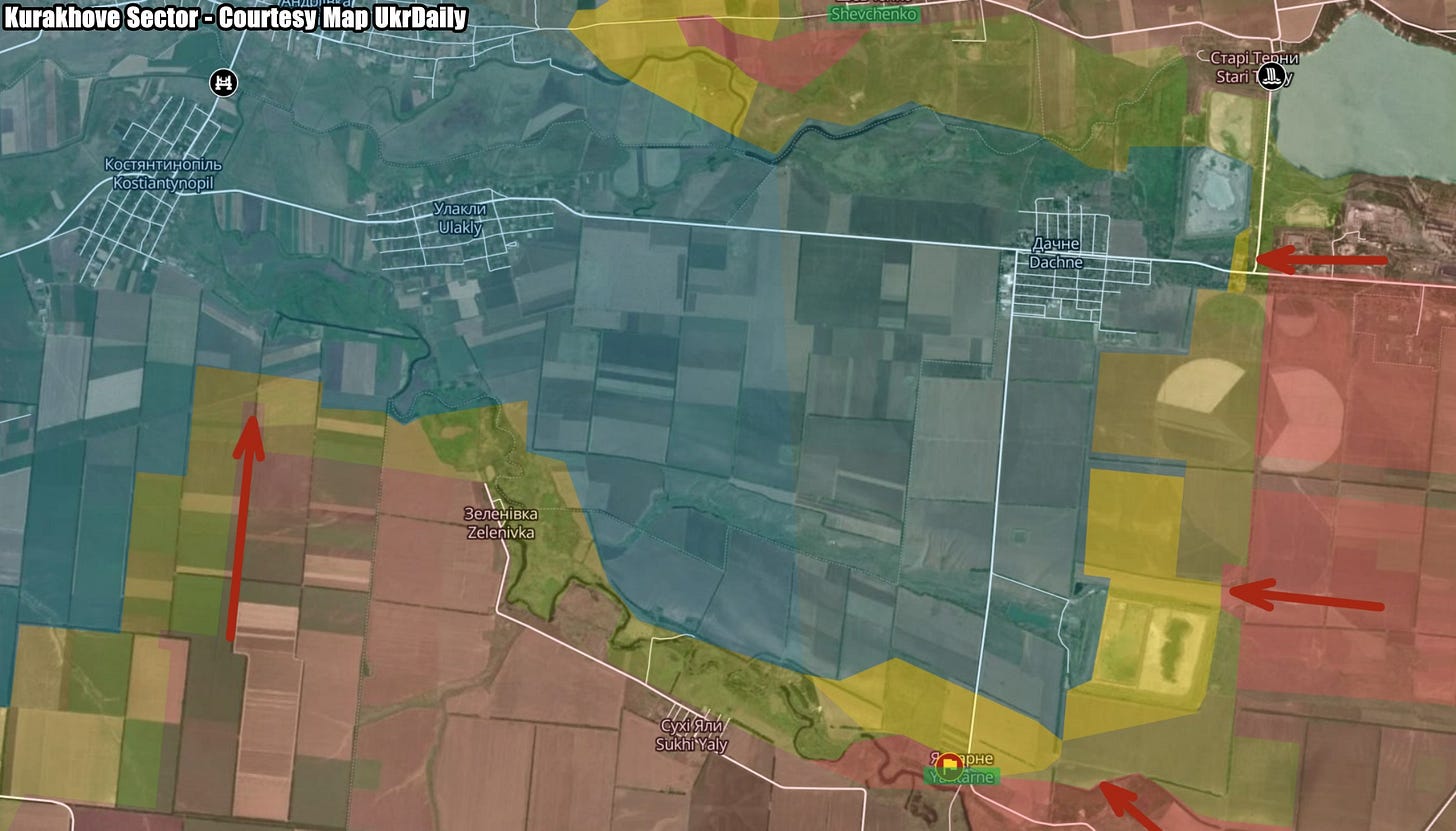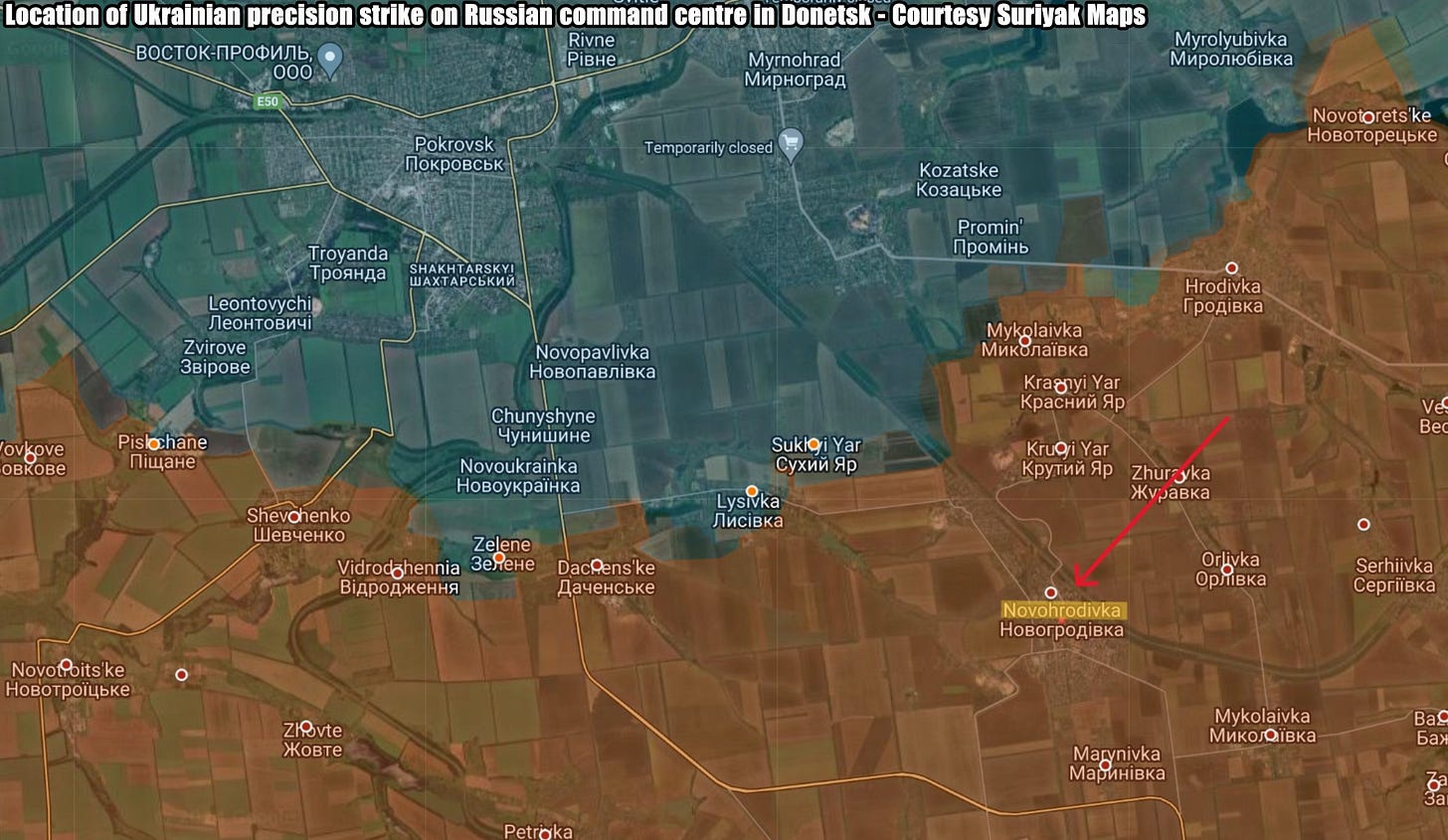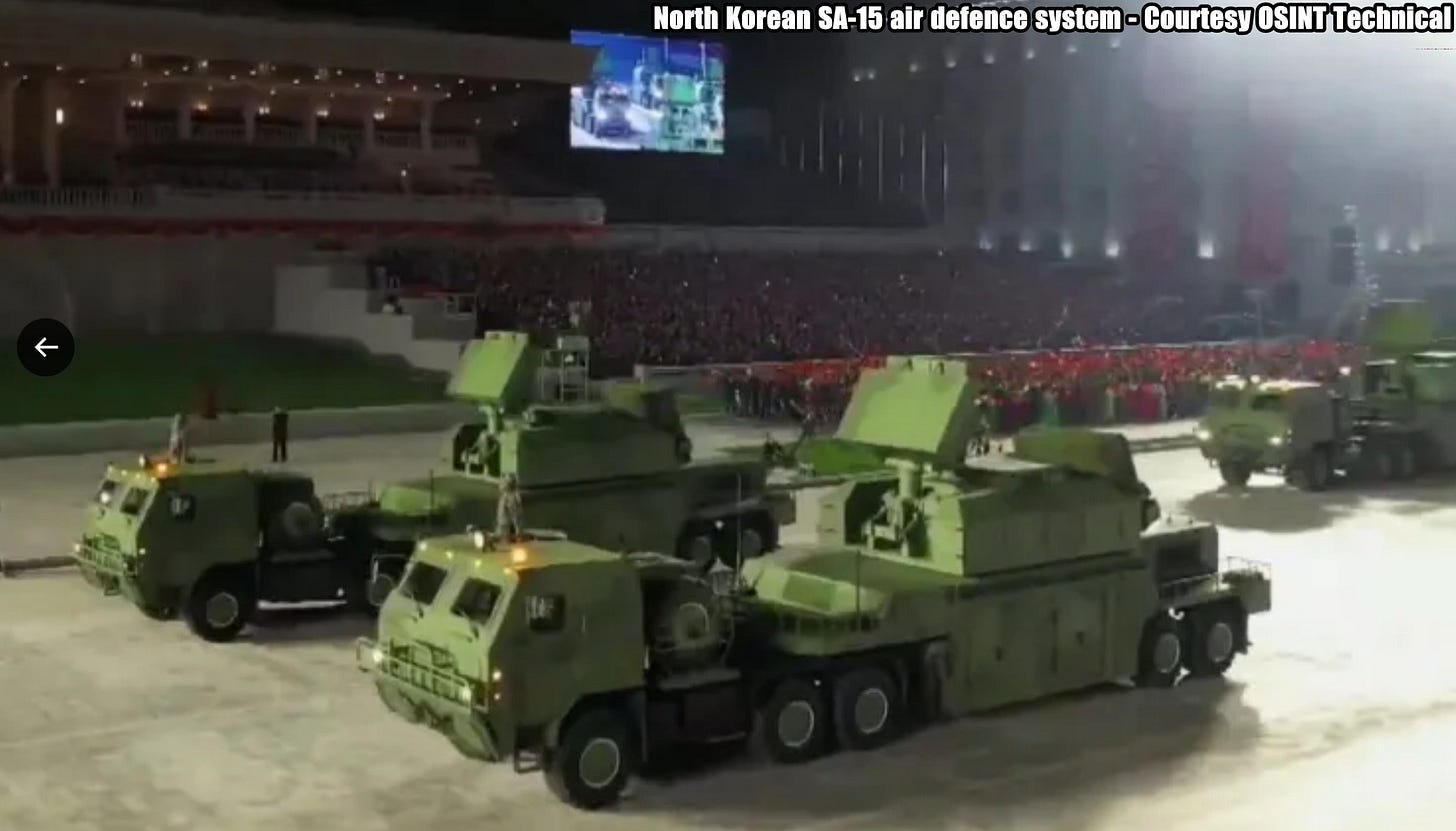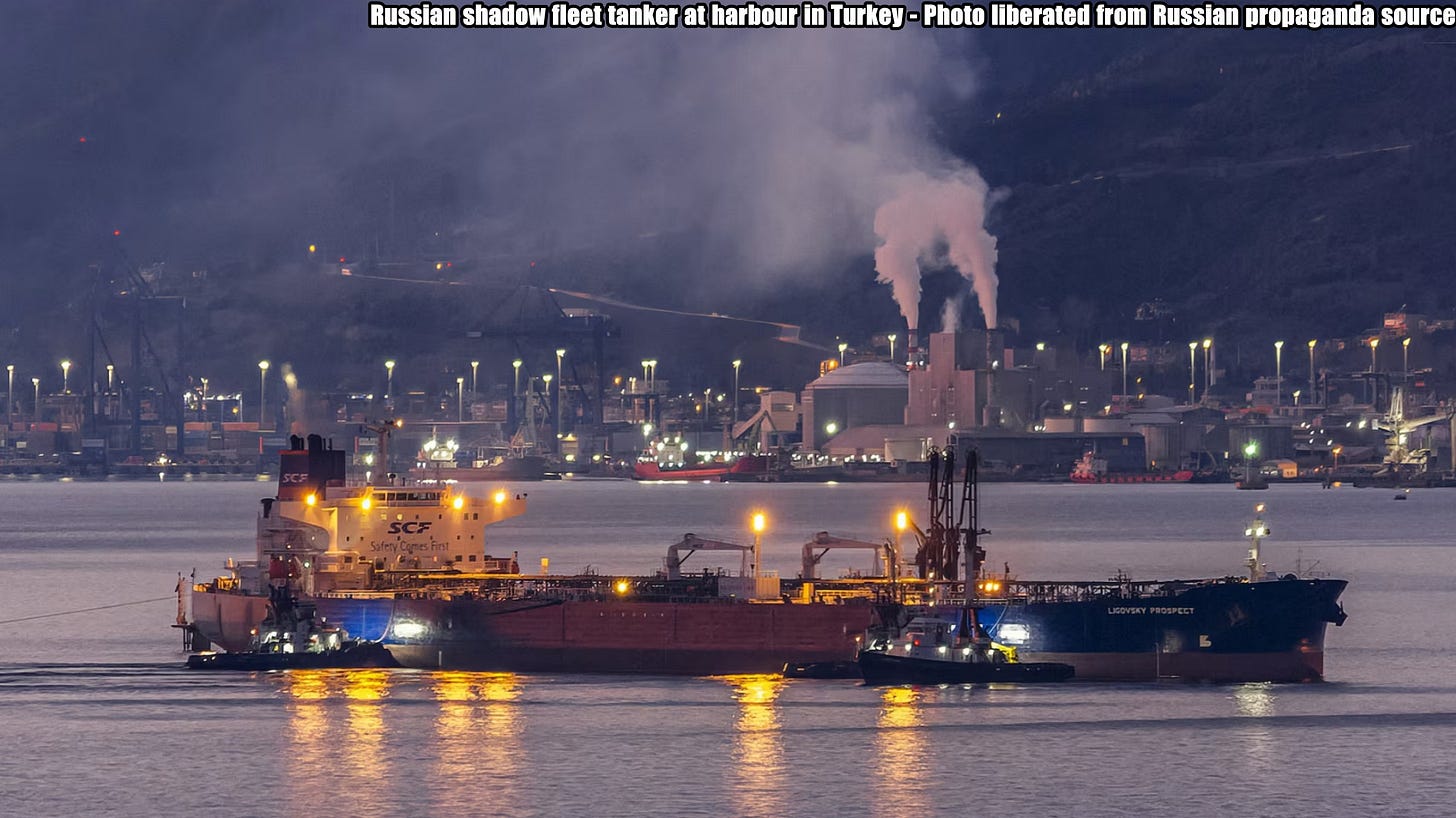Slava Ukraini! In early 2022 I began a Telegram channel aggregating news from a number of sources daily on the war in Ukraine. In June 2023 I began providing a daily draft for the Ukraine War Brief Podcast collecting news from over 70 sources daily, which formed the basis of the script. While the Podcast no longer exists I have continued to make this Brief available for my followers here on Substack for those who wish to keep up with the news from the war.
All the latest news on the Russo-Ukraine War 6 days per week
ALONG THE CONTACT LINE
GSAFU Morning Report
The General Staff of the Armed Forces of Ukraine in its Operational Information update at 08:00 on Jan 13 stated that day 1055 of the full-scale invasion of the Russian Federation against Ukraine had begun.
The situation on the line of combat remains tense in some sectors. Ukrainian defenders continue to actively counteract the Russian aggressor, causing them losses in personnel equipment and technology. Exhausting the enemy along the entire front line and continuing to disrupt the plans of Russian occupiers to advance deeper into the territory of Ukraine.
During the past two days, 324 combat engagements took place. Over the past 48 hours, the enemy carried out 1missile strike, 67 air strikes, used more than 4,763 drones and more than 11,,000 artillery strikes across the positions of Ukrainian forces and civilians.
-
Air Force Daily Report
60 ENEMY UAVS SHOT, 34 DRONES FAILED TO REACH THEIR TARGETS (LOCATIONALLY LOST)
➖➖➖➖➖➖➖➖➖
On the night of Jan 12, 2025 (from 6:00 p.m. on Jan 11), the enemy attacked with 94 Shahed attack UAVs and simulator drones of various types from the directions of Millerovo, Orel, Bryansk, Kursk — Russia.
The air attack was repelled by aviation, anti-aircraft missile troops, electronic warfare units, and mobile fire groups of the Air Force and Defense Forces of Ukraine.
As of 09:00, it was confirmed that 60 Shahed attack UAVs and drones of other types were shot down in Poltava, Sumy, Kharkiv, Cherkasy, Chernihiv, Kyiv, Zaporizhia, Kirovohrad, Zhytomyr, Khmelnytskyi, and Donetsk regions.
Several houses in the Kharkiv, Sumy, and Poltava regions were damaged by the fall of downed enemy drones (there were no casualties or injuries).
34 enemy drones-simulators - lost in location (without negative consequences).
78 ENEMY UAVS SHOT, 31 DROPPED DID NOT REACH THEIR TARGETS (LOCATIONALLY LOST)
➖➖➖➖➖➖➖➖➖
On the night of January 13, 2025 (from 7:00 p.m. on January 12), the enemy attacked with 110 Shahed attack UAVs and simulator drones of various types from the directions of Millerovo, Orel, Bryansk, Primorsko-Akhtarsk - Russia.
The air attack was repelled by aviation, anti-aircraft missile troops, electronic warfare units, and mobile fire groups of the Air Force and Defense Forces of Ukraine.
As of 09:00, it has been confirmed that 78 Shahed attack UAVs and drones of other types have been shot down in Poltava, Sumy, Kharkiv, Cherkasy, Chernihiv, Kyiv, Dnipropetrovsk, Mykolaiv, Zaporizhia, Zhytomyr, Khmelnytskyi, and Donetsk regions.
Due to the fall of downed enemy drones in Sumy, Kyiv, Zhytomyr and Zaporizhia regions, there is damage to buildings of enterprises, private and state institutions, private houses and vehicles (preliminarily without victims or injured).
31 enemy drone simulators — lost in location (without negative consequences).
Combat Operations in the Russian Federation
The Institute for the Study of War (ISW), a US based think tank, in its Jan 12 Russian Offensive Campaign Assessment reported that Russian forces recently crossed into northern Sumy Oblast as part of their ongoing efforts to eliminate the Ukrainian salient in Kursk Oblast. Geolocated footage published on Jan 10 indicates that Russian forces recently crossed the international border and advanced west of Zhuravka (north of Sumy City along the international border). A Russian milblogger claimed that Russian forces crossed into Sumy Oblast as part of their efforts to bypass Nikolayevo-Darino (east of Sudzha) from the south. A Russian milblogger claimed that Russian forces also advanced into northern Sumy Oblast near Prokhody (northeast of Sumy City), but ISW has not observed confirmation of this claim.
Russian forces continued offensive operations within the main Ukrainian salient on Jan 12 but did not make any confirmed advances. Geolocated footage published on Jan 11 indicates that Ukrainian forces maintain positions in Pogrebki (northwest of Sudzha) despite recent claims that Russian forces seized the settlement. Russian milbloggers claimed that Russian forces advanced northeast of Sudzha near Nikolskiy, Novaya Sorochina, Kruglenkoye, and Malaya Loknya; north of Sudzha near Kositsa, Russkoye Porechnoye, and Cherkasskoye Porechnoye; and south of Sudzha near Kurilovka. ISW has not observed confirmation of these claims, however.
A Russian milblogger claimed that elements of the Russian 1427th Motorized Rifle Regiment (formed during the 2022 partial reserve call up) repelled a Ukrainian attack near Russkoye Porechnoye. Elements of the Russian 34th Motorized Rifle Brigade (49th Combined Arms Army [CAA], Southern Military District [SMD]) are reportedly operating near Pogrebki, and elements of the 11th Airborne (VDV) Brigade reportedly continue to operate in Kursk Oblast.
The Khortytsia operational-strategic group
(Responsible for the northeastern part of Ukraine. )
Kramatorsk Sector: Russian forces recently advanced towards Orikhovo-Vaslivka north of Chasiv Yar on Jan 11, but were pushed back around Chasiv Yar itself.
Toretsk Sector: Russian forces recently advanced in Toretsk amid continued offensive operations in the area on January 12. Geolocated footage published on Jan 11 indicates that Russian forces recently advanced in northwestern Toretsk. Russian forces conducted offensive operations near Toretsk itself, northeast of Toretsk near Dyliivka, and west of Toretsk near Shcherbynivka on Jan 11 and 12.
The Tavria operational-strategic group
(Responsible for the central-eastern and southeastern part of Ukraine.)
Pokrovsk Sector : Russian forces advanced marginally west of Solone on Jan 11, and in the area of Novovasylivka.
Kurakhove Sector: Russian forces advanced marginally north of Yantarne on Jan 11, and west of Shevchenko on Jan 12.
The Odesa operational-strategic group
(Responsible for Kherson, Qırım, (also known as Crimea) and the Black Sea.)
There have been no major changes to the combat environment since our last report.
TEMPORARILY OCCUPIED TERRITORIES
Ukraine makes another high precision strike on a Russian command centre
The Institute for the Study of War (ISW), a US based think tank, in its Jan 12 Russian Offensive Campaign Assessment reported that the Ukrainian General staff announced on Jan 12 that Ukrainian forces conducted a high-precision airstrike on the command post of Russia's 2nd Combined Arms Army [CAA] (Central Military District) in Novohrodivka, Donetsk Oblast.
The Ukrainian General Staff noted that the operation is part of a broader series of Ukrainian strikes targeting command posts of Russian forces operating in the Donetsk direction. The Ukrainian General Staff reported on January 8 and 10 that Ukrainian forces struck the command posts of the Russian 8th CAA (Southern Military District) in occupied Khartsyzk, Donetsk Oblast, and the 3rd Army Corps [AC] (Central Military District) in occupied Svitlodarsk, Donetsk Oblast, respectively.
Ukrainian strikes on tactical command posts and positions located near the frontline, such as the strike against Novohrodivka, are likely intended to disrupt Russian tactical activity and directly complicate Russian command and control (C2) on the battlefield. Ukrainian strikes against main command posts further in the Russian rear, such as the January 8 strike on the Russian 8th CAA post, are likely aimed at degrading broader Russian logistics and operational planning efforts, which could have impacts on Russia's ability to conduct its military operations in western Donetsk Oblast.
ISW has observed that the 2nd CAA is currently leading Russian operations south of Pokrovsk, that the 3rd AC is operating near Chasiv Yar, and that the 8th CAA is leading Russian efforts near Kurakhove.
THE HOME FRONT
Zelenskyy - Ukraine’s Kursk operation thwarts Russian invasion plans.
Ukrainian President Volodymyr Zelenskyy told RaiNews24 in an interview that Ukraine’s operation in the Kursk Oblast was not driven by an objective to occupy Russian territory but is a necessary measure to ensure the country’s security.
Zelenskyy said Ukraine’s preemptive operation in Russia’s Kursk region has successfully disrupted Moscow’s plans for a northern invasion while forcing significant troop redeployments from other fronts.
On 6 January, Ukraine’s General Staff reported that since August 2024, Russian forces have suffered 38,000 casualties (killed and wounded), and 860 Russian soldiers have been taken prisoner in Kursk Oblast. As of January 2025, Ukrainian forces have been actively engaged in renewed offensive actions in the region, successfully repelling nearly 100 Russian assaults in one month alone.
Speaking with journalists, Zelenskyy explained that the operation was a preemptive step, as Ukrainian intelligence and its partners uncovered Russian plans to invade northern Ukraine, including troop build-ups aimed at occupying Sumy Oblast.
He added that 60,000 Russian troops are currently stationed in Kursk Oblast. This deployment has also benefited Ukrainian forces in Kharkiv Oblast, as Russia relocated a significant number of troops from there to Kursk Oblast.
“It was a tactical success for Ukraine, but it is not about occupation. We do not need their territory, their land, or their people. We simply want to live peacefully in our own homes, without war. That is all we seek,” Zelenskyy emphasized.
RUSSIAN WORLD
Russia's war spending may be twice its military budget, risking economic collapse.
The amount of Russia's military spending that is funded through a shadow financing scheme could be equal to its official military budget and may be contributing to rising inflation risks in the country, Craig Kennedy, a former investment banker at Bank of America and Morgan Stanley, reported in his “Navigating Russia” newsletter.
Since February 2022, Russian banks have been required to issue preferential loans to military enterprises on terms dictated by the state. According to Kennedy, over 70% of corporate loans in Russia since 2022 have been granted to sectors involved in the war.
Kennedy reports that over the three years of the war, this scheme may have provided the aggressor with funds equal to its official military budget. At the same time, it has led to unprecedented corporate borrowing, reaching US$415 billion.
"This report estimates that US$210 to US$250 billion of this surge consists of compulsory, preferential bank loans extended to defence contractors – many with poor credit – to help pay for war-related goods and services."
At the start of the full-scale invasion, the off-budget financing scheme helped Russia maintain its military budget at a controllable level, misleading international experts into believing the country faced no financial issues in funding the war.
However, Kennedy says Russia's current reliance on off-budget financing is creating problems, driving inflation and interest rate hikes.
Now the scheme risks triggering a systemic crisis due to disproportionately high interest rates, liquidity and reserve problems at banks, and a severely compromised monetary transmission mechanism.
Kennedy emphasises that the longer Moscow delays ending the war in Ukraine, the closer it will move towards corporate and banking collapses which the Russian government would be forced to cover. These difficulties could also lead to a fall in GDP.
Kennedy argues that Western resources can surpass Russia's capacity to sustain a war of attrition against Ukraine. He calls for continued support for Ukraine and tougher sanctions, and rejects any notion of sanctions being lifted in exchange for a ceasefire.
"Moscow’s funding challenges only increase from here, especially if coalition countries enforce more fully the powerful energy sanction tools at their disposal.
Through continued resolve and a clear understanding of Moscow’s vulnerabilities, Ukraine and its allies can realise the full potential of their negotiating leverage, avoid making unnecessary concessions, and reduce the longer-term risks posed by Russian revanchism."
Russian drone strikes North Korean air defense system
Russian media channels recently published a video claiming to show a successful strike on a “Western-made radar system” allegedly operated by Ukrainian forces. Defence Blog reports.
However, defense analysts have identified the destroyed system as a rare North Korean surface-to-air missile (SAM) system, possibly in Russian service. The footage, originally shared by the Russian channel “Povernutye na Voynie,” appears to document a friendly fire incident.
The air defense system shown in the video closely resembles a North Korean analog of the Russian Tor short-range SAM system, known by NATO as the SA-15. This particular vehicle, mounted on a semi-trailer with missiles positioned in its middle section, had not been previously identified in the conflict, raising questions about its origin and operational deployment.
Analysts believe the vehicle was misidentified, potentially by the drone operator responsible for the strike. The incident highlights the challenges of identifying advanced air defense systems in the fog of war.
Russia labels independent media outlet as 'terrorist group'
Russia's Federal Security Service (FSB) has designated the independent media outlet Komi Daily as a "terrorist organization," several news outlets reported on Jan. 13, citing recent changes on the FSB's website. The Kyiv Independent reports.
This marks the first time the FSB has applied such a label to a media outlet.
Komi Daily, known for its coverage of culture and daily life in Russia's northwestern Komi Republic, has been critical of Russia’s invasion of Ukraine. The outlet has faced escalating state pressure, including website blockages and fines against its editor for alleged incitement.
The FSB claims Komi Daily is linked to the Free Nations of Post-Russia Forum, a movement advocating for the decentralization and decolonization of Russia by dismantling it into 41 autonomous states. The outlet denies any affiliation with the forum.
The Supreme Court finalized the designation in late December, intensifying Russia's suppression of dissenting voices, particularly the independent media critical of the Kremlin.
The Free Nations of Post-Russia Forum, founded by Ukrainian entrepreneur Oleg Magaletsky and led by exiled Bashkir activist Ruslan Gabbasov, had already been labeled "undesirable" and "terrorist" by Russian authorities. Prosecutors allege the forum supports terrorism and sabotage while promoting the independence of regions like Komi.
The FSB's move is part of an expanding crackdown on independent journalism in Russia. The Kremlin has increasingly targeted media advocating for regional independence or criticizing the government, forcing many journalists into exile.
INTERNATIONAL NEWS
Tougher U.S. sanctions to curb Russian oil supply to China and India
Chinese and Indian refiners will source more oil from the Middle East, Africa and the Americas, boosting prices and freight costs, as new U.S. sanctions on Russian producers and ships curb supplies to Moscow's top customers, Reuters reported on Jan 12 citing traders and analysts.
The U.S. Treasury on Friday imposed sanctions on Russian oil producers Gazprom Neft and Surgutneftegas, as well as 183 vessels that have shipped Russian oil, targeting the revenues Moscow has used to fund its war with Ukraine.
Many of the tankers have been used to ship oil to India and China as Western sanctions and a price cap imposed by the Group of Seven countries in 2022 shifted trade in Russian oil from Europe to Asia. Some tankers have also shipped oil from Iran, which is also under sanctions.
Russian oil exports will be hurt severely by the new sanctions, which will force Chinese independent refiners to cut refining output going forward, two Chinese trade sources said. The sources declined to be named as they are not authorised to speak to media.
The expected disruption in Russian supply drove global oil prices to their highest in months on Monday, with Brent trading above $81 a barrel.
Among the newly sanctioned ships, 143 are oil tankers that handled more than 530 million barrels of Russian crude last year, about 42% of the country's total seaborne crude exports, Kpler's lead freight analyst Matt Wright said in a note.
Of these, about 300 million barrels were shipped to China while the bulk of the remainder went to India, he added.
"These sanctions will significantly reduce the fleet of ships available to deliver crude from Russia in the short term, pushing freight rates higher," Wright said.
A Singapore-based trader said the designated tankers shipped close to 900,000 bpd of Russian crude to China over the past 12 months."It's going to drop off a cliff," he added.
For the first 11 months last year, India's Russian crude imports rose 4.5% on year to 1.764 million bpd, or 36% of India's total imports. China's volume, including pipeline supply, was up 2% at 99.09 million metric tons (2.159 million bpd), or 20% of its total imports, over the same period.
China's imports are mostly Russian ESPO Blend crude, sold above the price cap, while India buys mostly Urals oil.
Vortexa analyst Emma Li said Russian ESPO Blend crude exports would be halted if the sanctions were strictly enforced, but it would depend on whether U.S. President-elect Donald Trump lifted the embargo and also whether China acknowledged the sanctions.
The new sanctions will push China and India back into the compliant oil market to seek more supply from the Middle East, Africa and the Americas, the sources said.
Spot prices for Middle East, Africa and Brazilian grades have already risen in recent months on rising demand from China and India as supplies of Russian and Iranian oil tightened and became more expensive, they added.
"Already, prices are rising for Middle Eastern grades," said an Indian oil refining official. "There is no option than that we have to go for Middle Eastern oil. Perhaps we may have to go for U.S. oil as well."
A second Indian refining source said the sanctions on Russian oil insurers will prompt Russia to price its crude below $60 a barrel so Moscow can continue to use Western insurance and tankers.
Last month, the Biden administration designated more ships dealing with Iranian crude ahead of tougher action expected from the incoming Trump administration, leading the Shandong Port Group to ban sanctioned tankers from calling into its ports in the eastern Chinese province.
As a result, China, the main buyer of Iranian crude, will also turn to heavier Middle Eastern oil and most likely will maximise its offtake of Canadian crude from the Trans-Mountain pipeline (TMX), Tchilinguirian said.
Russia condemns new US energy sector sanctions, says it will continue oil and gas projects.
Russia criticized the latest U.S. sanctions targeting its energy sector on Jan. 11, describing them as an effort to harm Russia's economy while risking instability in global markets. Despite this, the country's Foreign Ministry said Russia would continue pursuing major oil and gas projects. The Kyiv Independent reports.
The ministry condemned Washington's "hostile" actions, announced on Jan. 10, and noted that Russia would craft its foreign policy strategy in response. The ministry argued the sanctions represented "an attempt to inflict at least some damage to the Russian economy, even at the cost of the risk of destabilising world markets as the end approaches of President Joe Biden's inglorious tenure in power."
The sanctions mark the most extensive U.S. measures yet against Russia's oil and gas revenue streams. They aim to provide Kyiv and the incoming administration of Donald Trump with leverage to negotiate an end to the war in Ukraine.
The U.S. Treasury sanctioned Gazprom Neft, Surgutneftegas, and 183 vessels involved in transporting Russian oil, many of which belong to the so-called shadow fleet of aging tankers operated by non-Western companies.
Combined, Gazprom Neft and Surgutneftegas reportedly produce over 1 million barrels of oil daily, generating an estimated $23 billion of revenue annually, according to the U.S. Treasury.
President Volodymyr Zelenskyy welcomed the sanctions, saying they would "deliver a significant blow" to Russia. "The less revenue Russia earns from oil ... the sooner peace will be restored," he added.
Russian 'shadow fleet' tankers carrying 2 million barrels of crude idling off China’s coast.
Three tankers carrying more than 2 million barrels of Russian oil are floating in waters off eastern China after they were sanctioned by the US on Friday, according to ship-tracking data. Bloomberg reports.
The Huihai Pacific was due to arrive at Dongjiakou in Shandong province on Jan. 15, after loading nearly 770,000 barrels of ESPO crude from the Russian Pacific port of Kozmino earlier in the month, according to data intelligence firm Kpler. However, it changed course over the weekend and is now parked offshore and laden with oil.
The ship, alongside many others, was swept up in the most aggressive package of measures targeting Russian oil exports since the invasion of Ukraine in early 2022. Several tankers and at least one trader active in the trade of ESPO, a grade that’s favored by China’s independent refiners, or teapots, were sanctioned.
The Mermar left Kozmino on Jan. 5 with more than 755,000 barrels of ESPO and was scheduled to call at Yantai port this week, but is now waiting off the coast, the Kpler data show. The Olia departed the Russian port on Jan. 7 with nearly 709,000 barrels of the grade, and was also bound for Yantai, but is now sitting in the Yellow Sea.
Washington’s move comes just days after the Shandong Port Group Co., which runs several ports in the province, urged terminals to stop allowing sanctioned oil tankers to dock or offload cargo.
MILITARY & TECH
UK Defense Intelligence Indicate Grinding Russian Advances and Strong Ukrainian Resistance in Urban Areas.
The UK Ministry of Defence in their Jan 12 Intelligence Update on Ukraine stated that in the north of Donetsk region, fighting has continued for control of Chasiv Yar and Toretsk. Russia has been attempting to gain control of the two towns, which serve as the gateway to the Donetsk cities of Kramatorsk and Kostyantynivka, since early 2024. Russian forces attempted assaults in Chasiv Yar and Toretsk with armoured vehicles in late December 2024 and early January 2025. It is likely that these attacks were repelled in Chasiv Yar, but in Toretsk russia has continued to advance.
Russian forces likely control at least 70 per cent of Toretsk, and have made grinding progres through the town, but urban fighting has inhibited rapid advancement. In Chasiv Yar, the Siverskyi Donets-Donbas canal serves as the current line of control.
Advancing russian forces are frequently targeted by Ukrainian UAV operators as they approach the canal. Russian forces have been attempting to interdict Ukrainian logistics routes in and out of these towns.
That’s it for today’s Brief folks if you would like to keep up with events in Ukraine daily please consider subscribing, it’s free!


